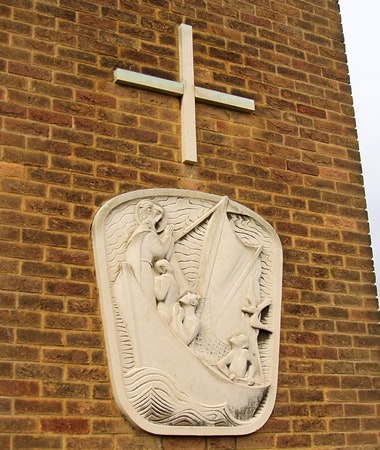
Coventry City Council is currently considering a planning application for the demolition of St Nicholas Church, Radford, and the redevelopment of the site for affordable housing. The Coventry Society has responded to the planning application expressing our very serious concerns about the way in which the building has been neglected over many years, ending up with a situation where the demolition of St Nicholas is virtually a fait accompli.
The church has been a significant local landmark since its consecration in 1955. The building was designed by nationally important architects, Lavender, Twentyman and Percy. The design of both the interior and exterior of the church were striking and innovative. It was added to the City Council’s local list of architecturally important buildings in 1992. It has been recognised locally and nationally as a fine example of post war, innovative British architecture, although Historic England declined to list the building as being of national architectural and heritage importance.
However, over the last 20 years, the building has been allowed to deteriorate to the extent that the conclusion in the Heritage Impact Assessment accompanying this planning application is that the possibility of refurbishment is “unrealistic” The cost of refurbishment is estimated to be £2.8 million. Photographs accompanying the planning application show how what once was an impressive, bright, modern church is now a waterlogged shell in appalling condition.
St Nicholas was last used for worship in 2009 and has been vacant and disused since that time, with its condition gradually, but steadily deteriorating. Over a considerable period, roofing materials were stripped from the church, stolen and not replaced. Faults in the original design of the building became apparent. But at no time was an effective strategy for maintaining the building apparent. We have to ask how the deterioration and degradation of such a significant building, an important example of Coventry’s ground – breaking post war architecture, has been allowed to take place.
We were not party to decisions taken or not taken in relation to the maintenance of St. Nicholas over the last twenty years, and it is not clear whether there was ever a decision to intentionally allow the building to decay, or whether this happened by default. However, the diocese of Coventry has a responsibility to the City and to the community served by this church and should be held responsible for decisions taken and not taken which have led to the sad situation in which we now find ourselves. They should at least make clear how this situation arose.
We have reached the stage with St. Nicholas, where an objection to the application to demolish is pointless. The building is beyond reasonable refurbishment. The damage has been done over a long period during which time the building has been sorely neglected. The important lesson to learn from this case now is that other significant post war Coventry buildings, and churches in particular, should not be allowed to deteriorate in this way.






